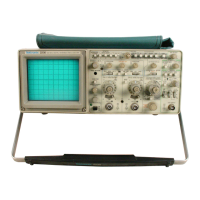--
GLITCH MEASUREMENT. Once a glitch has
been
observed, you may wish to obtain measurements of
amplitude and pulse width. The following procedure may
be
used to acquire the glitch
in
STORE mode using
delayed sweep. By selecting appropriate trigger sources,
the procedure may
be
used for any similar waveform
situation (i.e., selecting triggers that set up a storage
window containing the pulse,
or
glitch, to
be
acquired).
To view the glitch
in
the pulse train for measurement
purposes:
1 . Preset instrument controls and obtain a baseline
trace, with the following exceptions:
STORE/NON STORE
TRIG MODE
A TRIGGER SOURCE
HORIZONTAL MODE
STORE (button
in)
NORM
EXT (error event)
BOTH
2.
Adjust the A TRIGGER SLOPE and LEVEL controls
for a stable display of the A trace. Set the B TRIGGER
LEVEL control fully cw.
3.
Set the A SEC/DIV switch to display the portion
of
the pulse train containing the glitch. Pull the B SEC/DIV
knob to unlock it from the A SEC/DIV switch,
and
set the
B SEC/DIV switch to reduce the intensified zone to the
size of the area
of
interest (see Figure
6-1
SA).
4.
Use the B DELAY TIME POSITION control to move
the intensified zone to the area
of
the signal containing the
glitch.
5.
Set the HORIZONTAL MODE switch to
B.
6.
Using the Menu, select either PEAKDET or
ACCPEAK Acquisition mode.
7.
Adjust the INTENSITY control
as
necessary for
desired display brightness. The glitch should
be
seen
in
the
display (see Figure
6-1
SB).
It may
be
expanded further
by
setting the B SEC/DIV switch to faster sweep speeds (see
Figure
6-1
SC).
8.
Set the SAVE/CONTINUE switch to the SAVE posi-
tion (button in) to hold the acquired waveform
and
provide
a more stable display for measurement. The SAVE
ACQUISITION mode display may
be
horizontally expanded
up to 10 times using the SEC/DIV switch (if enough
Basic
Applications-2230
Operators
SEC/DIV switch positions remain) and vertically expanded
up to 10 times, using the VOL TS/DIV switch associated
with the channel from which the signal was acquired.
NOTE
PEAKDET Acquisition mode will catch
at
least 50%
of
the amplitude
of
a pulse as narrow as 100
ns.
If
the glitch is repetitive, its shape may be observed
at
sweep speeds faster than 5
µS
per
division (REPETI-
TIVE Store sampling).
90
I-
-
~
I-
I-
I-
IO
(A) BOTH HORIZONTAL DISPLAY.
A TIME/DIV AT 2ms/DIV.
90
IO
(B) STORE MODE B HORIZONTAL MODE.
B TIME/DIV AT 2µs/DIV.
90
.
IO
(C) STORE MODE B HORIZONTAL MODE.
B TIME/DIV AT 0.Sµs/DIV.
4998-28
Figure 6-15. Glitch display, STORE mode using B HORIZONTAL
MODE.
MISSING PULSE. ACCPEAK mode
is
useful for finding
an
intermittent pulse
in
a pulse train. The pulse may either
be missing or present erratically.
In
either case, the
change
in
amplitude levels
is
displayed as a completely
filled
in
pulse (see Figure 6-16).
6-15

